AMD Athlon 64 4000+ & FX-55: A Thorough Investigation
by Anand Lal Shimpi on October 19, 2004 1:04 AM EST- Posted in
- CPUs
Multitasking Content Creation
MCC Winstone 2004
Multimedia Content Creation Winstone 2004 tests the following applications in various usage scenarios:
. Adobe® Photoshop® 7.0.1
. Adobe® Premiere® 6.50
. Macromedia® Director MX 9.0
. Macromedia® Dreamweaver MX 6.1
. Microsoft® Windows MediaTM Encoder 9 Version 9.00.00.2980
. NewTek's LightWave® 3D 7.5b
. SteinbergTM WaveLabTM 4.0f
As you can see above, Lightwave is part of the MCC Winstone 2004 benchmark suite. As an individual application, Lightwave does manage to get a healthy performance benefit with multithreaded rendering enabled, especially when paired with Hyperthreading enabled CPUs like the Pentium 4s here today. The latest MCC Winstone patch allows for a selection of how many threads to launch during the Lightwave test, the options range from 1 - 8 threads.
Based on our tests it seems as if 4 threads yields the highest performance on the Pentium 4 platform, and thus we used that setting for all of our tests. The Athlon 64s perform identically with 1 or 4 threads as they are not multithreading capable processors, so the AMD scores did not change.
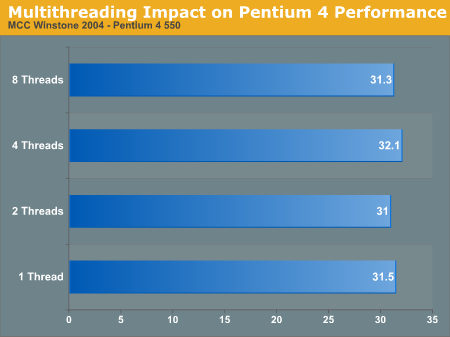
Despite the inclusion of Hyperthreading support, MCC Winstone 2004 still shows AMD performing much better in an area where Intel once dominated. While the Prescott based Pentium 4 560 is at the front of the Intel pack, it is still outperformed by the Athlon 64 3400+.
Here the single vs. dual channel memory gap shrinks to under 3% when we compare the 3400 and 3800+ processors, but also worth noting that the added cache of the 4000+ is also only responsible for about a 2% performance gain. Put the two together and you've got a decent combination in the Athlon 64 4000+, but separately the features don't bring much to the table to justify the added cost.
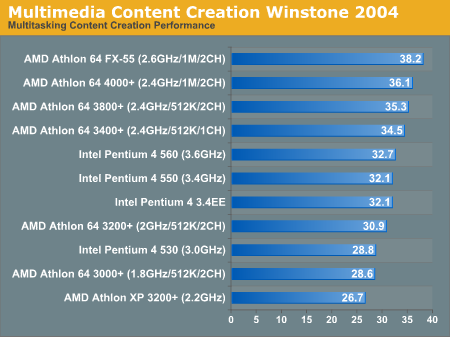
ICC SYSMark 2004
The first category that we will deal with is 3D Content Creation. The tests that make up this benchmark are described below:
"The user renders a 3D model to a bitmap using 3ds max 5.1, while preparing web pages in Dreamweaver MX. Then the user renders a 3D animation in a vector graphics format."
Intel has historically done very well under SYSMark 2004, especially when it comes to Internet Content Creation applications. Here we've got a number of very NetBurst friendly applications running at the same time and the results aren't too surprising.
For once we have the Pentium 4 560 out on top, distancing itself from the Athlon 64 FX-55 by almost 5%. The Prescott core flexes its muscle as the longer pipeline does it no harm, with the Pentium 4 550 performing on level ground with the Northwood based 3.4EE.
The three 2.4GHz AMD chips settle in the middle of the pack, followed by the Pentium 4 530 and the remaining Athlon 64s and Athlon XP. 3D rendering continues to be a strongpoint for the Pentium 4, with the combination of 3D rendering and animation giving Intel the much needed lead here.
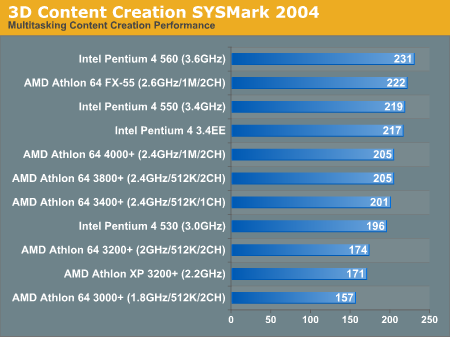
Next, we have 2D Content Creation performance:
"The user uses Premiere 6.5 to create a movie from several raw input movie cuts and sound cuts and starts exporting it. While waiting on this operation, the user imports the rendered image into Photoshop 7.01, modifies it and saves the results. Once the movie is assembled, the user edits it and creates special effects using After Effects 5.5."
The race is much closer in the 2D Content Creation test, with the Pentium 4 560 virtually tied for the lead with AMD's Athlon 64 FX-55.
Once again we see no difference between the 512KB L2 3800+ and the new 4000+ armed with a 1MB L2 cache. There continues, however, to be a slight performance impact when going down to the single channel Athlon 64 3400+.
Looking at the Athlon XP we see just how important the Athlon 64 has been
to AMD, without it we'd be analyzing another Intel dominated test.
Here's another situation where Prescott seems to be breaking even when
it comes to performance. Remember that Prescott's lengthened pipeline should
penalize it significantly, but thanks to Prescott's other core optimizations
and larger cache it manages to perform just as well as the Northwood based
Extreme Edition here.
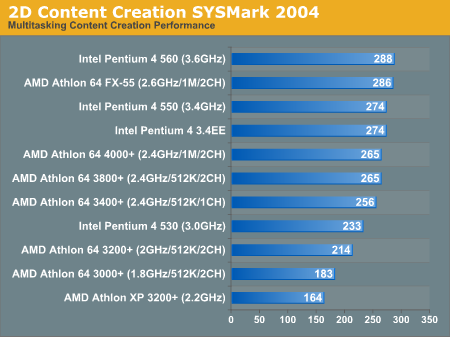
The Internet Content Creation suite is rounded up with a Web Publishing performance test:
"The user extracts content from an archive using WinZip 8.1. Meanwhile, he uses Flash MX to open the exported 3D vector graphics file. He modifies it by including other pictures and optimizes it for faster animation. The final movie with the special effects is then compressed using Windows Media Encoder 9 series in a format that can be broadcast over broadband Internet. The web site is given the final touches in Dreamweaver MX and the system is scanned by VirusScan 7.0."
The situation remains mostly unchanged in SYSMark's final Internet Content Creation test. The Pentium 4 560 heads up the pack, followed very closely by the Athlon 64 FX-55 as well as the Pentium 4 550 and 3.4EE.
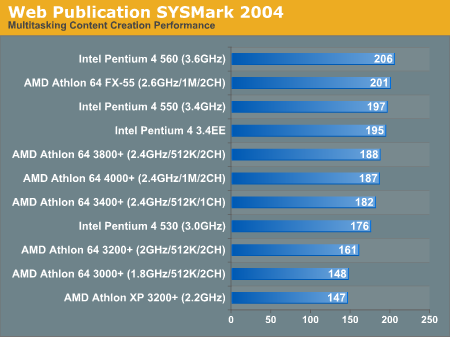
Mozilla + Media Encoder
While AMD dominated in WorldBench 5's Mozilla test, encoding a file using Windows Media Encoder in the background not only makes this test more appreciative of the Pentium 4 but also of Hyper Threading.
Despite the seemingly perfect Hyper Threading scenario, it doesn't help Intel win the lead here. The Athlon 64 FX-55 and the 4000+ manage to win here, followed by the 3.4EE. Without any spatial locality between the two very different applications being run enabling Hyper Threading essentially gives each one of the applications half of the cache they would have running solo, thus giving the 3.4EE an advantage over the Pentium 4 560.
We also see that the cache advantage is clearly present on the AMD side as well, with the 4000+ enjoying a 6.7% advantage over the 3800+, with the only difference between the chips being an additional 512KB of L2 cache.
The rest of the results are no surprise given the leaders, the Athlon 64 continues to be quite strong here.
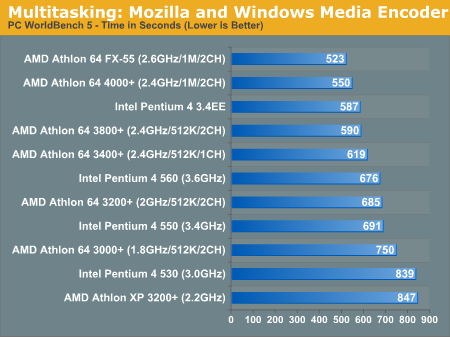










89 Comments
View All Comments
coolme - Monday, January 10, 2005 - link
#85 yeah, but when comparing to Tom's Hardware review, it's totally off track... (Tom's is more believeble because there is pics of how he measured it and based on the fact that there is no way a A64 could handle 200+ watts)http://www6.tomshardware.com/cpu/20041115/pentium4...
how Tom tested it: http://www6.tomshardware.com/cpu/20041115/pentium4...
eight - Monday, December 27, 2004 - link
Has anyone information about A64 performance with Premiere Pro 1.5? I assume thet A64 does beat P4, but assumption is mother of... :)euanw - Tuesday, November 9, 2004 - link
#44Wesley,
I am very impressed by your articles. Can you inform me of the procedure you used to overclock the FX55? With the Neo2 board I am not clear on CPU vid and CPU voltage, what do they mean? When I change the multiplier to 13.5 my new PC reaches winXP and then reboots.
My setup is MSI K8N-Neo2-54G, FX-55, 2 x 512MB - OCZ EL DDR PC-3200 Platinum Rev2, Nvidia Quadro FX3000, 2x Seagate Barracuda 7200.7 120 GB, Matrox RTX-100 real time video editor, Antec TrueBlue 480W ATX-12V, BenQ DVD Dual DW1610, WinXP-SP2.
euanw - Tuesday, November 9, 2004 - link
#44Wesley,
Gioron - Sunday, October 24, 2004 - link
While I'm unsure of the exact method used in this review, I'm sure that there is no built-in power measurement devices on the motherboards and processors listed (unless its new and no one told me...) so its NOT just just a matter of installing software that can read a sensor thats already there (as in all the CPU temp monitors). This means it requires some hardware to measure the voltage and current flow to various components (or you can cheat a little and assume the voltage is constant and just measure current).Unfortunately, this is not as easy as it sounds, since isolating various components can be a problem. Its fairly easy to measure things like hard drive power useage since there is only one power connector going to it and its easy to access, so you measure the current on the 5v line and the current on the 12v line, and you're pretty much done. Things like CPUs, motherboards and graphics cards are a bit more difficult. On the newer graphics cards you can measure the power consumption from the additional molex connector, but in all likelyhood, the card will also draw a certain amount of power from the AGP slot power lines, and no one in their right mind is going to unsolder the AGP slot and raise it half an inch in an attempt to put a current sensor in line with the power leads. Thus, you need to rely on indirect means and educated guesses. You can measure the current going into the motherboard, but how much of that is going to the chipset, the CPU, the RAM and the graphics card? You can swap in a different CPU and see how it changes, but that won't give you absolute readings. You can try to remove the CPU and see what power the MB uses without one, but odds are it'll use more power when its actually interfacing with a CPU instead of beeping error codes at you.
Bottom line: There is no easy way to measure power consumption, and even dedicated hardware review sites have problems with it. Personally, I trust Anand far enough that I'm sure he didn't completely screw it up, and the numbers he has are probably close enough to the real thing. I'd forget about measuring power for myself.
xsilver - Friday, October 22, 2004 - link
Kinda late on the comments but..If anand or anybody can answer -- what is used to measure the "power consumption" software? or hardware? links? I would like to test this myselfthanks
Bakwetu - Friday, October 22, 2004 - link
Whoah, it's been a while since I checked out cpu reviews and I must say Amd has some impressive cpu:s nowadays. Even though I am budget oriented when it comes to buying hardare, I'd choose the 3400+ model before the 3200+, it's not all that much more expensive and seems to perform much bettert - Friday, October 22, 2004 - link
79uhuh.... and in a server type situation, how many raid arrays are ran off the chipset controllers? not many i would wager..
hell... u prolly have an independent fibre optic raid array :)
hardware, baby, hardware.
t.
knitecrow - Friday, October 22, 2004 - link
I always knew women were trouble when it comes to technology ;)screech - Thursday, October 21, 2004 - link
nice ones #79, 78. :)